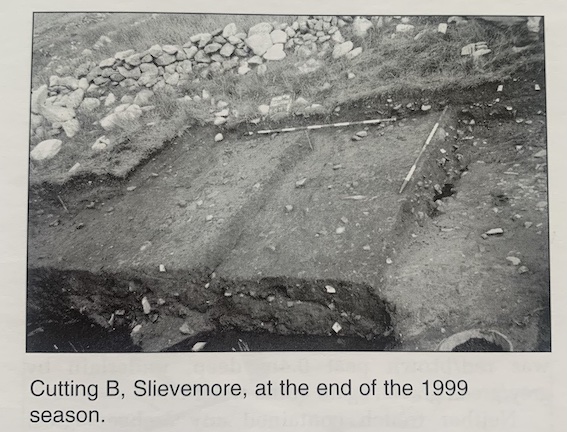County: Mayo Site name: THE DESERTED VILLAGE, Slievemore (Achill Island)
Sites and Monuments Record No.: SMR 41:00802; 42:10914 Licence number: 91E0047
Author: Theresa McDonald
Site type: Settlement cluster
Period/Dating: Multi-period
ITM: E 468568m, N 803481m
Latitude, Longitude (decimal degrees): 53.963908, -10.003031
The tenth season of survey and excavation at the Deserted Village in Slievemore took place over eight weeks from 26 June to 18 August 1999. The 1999 season continued the excavation in Cuttings A, B and C in the vicinity of House #36 and at the Monk's Garden in the village of Tuar. The instrument survey continued in Tuar Riabhach and in the neighbouring village of Faiche.
Cutting A
Excavation continued in Trench F18 outside the north gable of House #36. Previously, a French drain had been noted here, suggesting pre-planning before the construction of this house (c. 1800).
Further excavation revealed an abundance of finds, all of late 19th-century date and probably belonging to the 'booley' phase of occupation, c. 1860–1940.
Cutting B
The deposits in this area have been interpreted as lazy-beds that on stratigraphical evidence seem to pre-date the construction of House #36. Underneath a mixed organic deposit were two long, rectangular deposits of a rich, orange ash that extended north-south across the cutting. This deposit appears to have been laid down before the setting of the lazy-beds, for the purpose of 'flattening' this area for reasons unknown at present. The lazy-beds are of a fairly substantial nature but were deliberately shortened as they approached the western end of Cutting B and seem to be related to the presence of the French drain referred to above.
Excavations in F13 of Cutting B produced two tiny beads, one white and the other pale blue, parts of two shoes with metal heels and leather soles, a burnt fragment of a clay pipe stem, pieces of slag, glass, pottery and metal, and fragments of wood and charcoal. A portion of red brick had a small area of glaze on one surface.

Cutting C
Excavations in Cutting C revealed a series of small pits that were successively dug and refilled at different rates and at different times. It is even possible that that some were dug into previously refilled pits, such is the complex nature of the stratigraphy in this area. The function of these pits is unknown as, apart from one fragment of hematite, no diagnostic artefacts have been found. Two of the pits were covered with very similar large boulders, and there was evidence of slag adhering to the rims of two of the pits.
Monk's Garden excavation
Excavation this year was concentrated inside the souterrain and in the area immediately outside the entrance. The fill inside the souterrain was removed to reveal two side-walls made up of large orthostats, while the roof consisted of three large lintels that descended in height towards the rear. Underneath the innermost lintel is a 'wall' of compact clay, and below this are two upright stones set into the fill on either side of the passage. The passage curves to the east, and it is possible that it descends into a 'drop-hole' creep.
The excavation will continue in 2000.
St O'Hara's Hill, Tullamore, Co. Offaly